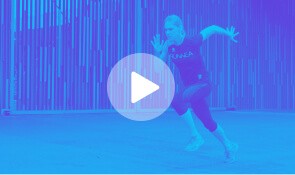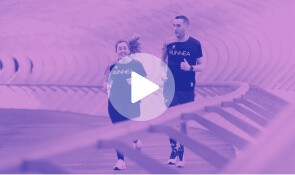At what pace do I have to run in my training to improve my race times?
Every runner, at some point in our sporting life, has wondered if we are training at the right pace. It is a natural, almost inevitable doubt, especially when we have the desire to improve our times and our performance becomes part of our daily motivation. However, while many popular runners, we focus on the numbers dictated by the clock, I wonder is it really necessary to obsess about those rhythms? Or is it possible that we are leaving aside something equally or more important: the enjoyment and connection with our body?
Not sure which running shoe to choose?
In a few simple steps we help you to choose the ideal running shoe for you
Go to the Shoe FinderThe science of training gives us clear answers, but it's important to balance data with personal experience. At RUNNEA we would like to talk to you about types of training, recommended paces according to scientific evidence, and how to find that necessary balance between performance and enjoyment when running.
The importance of paces in training
Before we dive into the details of training types and paces, it's key to understand why paces are important. Proper pacing is going to help you avoid overtraining, but it also optimizes the body's adaptation to exertion. According to a study published in the Journal of Applied Physiology, maintaining proper pacing during training improves aerobic capacity and allows the body to use oxygen more efficiently.
But this is where we can open the debate. While the science supports the benefits of monitoring paces, not all training requires obsessive attention to numbers. Runners don't train to break world records, and if we focus too much on the heart rate monitor, we can lose what really makes us enjoy the sport.
Key workouts and their paces
Now that we understand the importance of pacing, it's very important to break down the different types of training and their respective paces, and we're going to rely on our team of coaches and scientific evidence.
Light or aerobic-based pacing.
This is the cornerstone of any running training plan, especially for recreational runners. Running at a comfortable pace, which allows you to talk without difficulty, improves cardiovascular capacity and increases endurance without risking premature fatigue. A study in the International Journal of Sports Physiology and Performance states that this type of training should account for approximately 70% of the weekly volume for amateur runners. Here's where things get interesting: in this type of running, pace is not the most important thing. What's more relevant is how you feel. Listening to your body and adjusting your effort according to how you feel is key to preventing injury and maximizing recovery.
High-intensity interval or set training
Sets are essential for improving speed and efficiency. Studies show that running intervals at paces close to your anaerobic threshold (approximately the pace at which you can maintain high intensity for 20-30 minutes) improves specific endurance and overall race time. Here, pace plays a more important role, as running too slow or too fast reduces training benefits. However, as recreational runners, precision to the second should not be our obsession. Adjusting intervals to our individual capabilities is the key.
Running at threshold pace
Lactate threshold training is one of the most effective ways to improve speed in long distance running. This pace is usually the one you can maintain during a 10-kilometer run, or around 85-90% of your maximum heart rate. Training at this threshold improves your ability to sustain a higher effort for longer periods without accumulating fatigue quickly. According to a study in the European Journal of Applied Physiology, this type of training should be done once or twice a week to avoid overtraining. Again, pacing is important, but listening to your body and adjusting according to your fitness level is just as crucial.
Fartlek Training
Fartlek, or "speed play," is one of the most flexible and adaptable workouts. It combines periods of exertion at varied paces with active recovery. The pace here is less important than the variation and challenge of running at different intensities. A study in the Journal of Strength and Conditioning Research suggests that this type of training is excellent for improving both aerobic and anaerobic endurance. Plus, it adds a playful component that helps disconnect from the pressure of numbers and the clock.
Pacing and the obsession trap.
It's easy to fall into the trap of perfect paces, of wanting to follow the training plan to the letter. But is it really necessary to be so exact? For professional athletes, paces are critical, but for most of us, the most important thing should be to enjoy the process.
Haruki Murakami, in his celebrated book What I Talk About When I Talk About Running, suggests that running is not just about improving times. It is a form of personal connection, a form of meditation in motion. If we are always watching the clock, when do we give ourselves a chance to simply enjoy the experience?
I don't mean we should ignore paces, but it's important to find a balance. As recreational runners, we often forget that running is something we love. The word "amateur" comes from the Latin "amare," which means "to love." We started in this sport out of passion, out of love for movement, and it is crucial not to lose that essence.
How do you find the balance between performance and enjoyment?
The key to finding the balance between improving times and enjoying running is to listen to your body. Training plans are gu, not absolute rules. Adjusting your pace according to how you feel each day is essential to avoid physical and mental exhaustion.
- Run by feel on key days: If you feel fatigued, don't be afraid to slow your pace, even if the plan says otherwise. Rest and recovery are as important as effort.
- Plan enjoyable workouts: Include light runs where pace doesn't matter. Go for a run just to enjoy the wind in your face, the quiet of the park or the sound of your shoes hitting the ground.
- Be flexible with goals: Having goals is essential to improve, but being flexible and adapting them according to your progress is just as important. Don't beat yourself up if one day you don't hit your planned pace; every workout counts.
Your first personalized trainer, no matter your level or experience.
Training without a proper plan can be overwhelming, especially when you're reaching for a specific meta, such as your first 5K race or improving your half marathon time. This is where a customized tool makes all the difference, and at RUNNEA we know this well. We want anyone, no matter if you're a beginner or an experienced runner, to have access to training tailored to your needs.
Never had a personal trainer? With the free RUNNEA app, you can experience the feeling of having a personalized coach at your disposal, who will accompany you from the first step to the meta line.
With more than 10 years of experience helping runners of all levels, at RUNNEA we provide you with an app that combines human knowledge with artificial intelligence to design training plans tailored to your fitness level, time availability and specific goals.
Free RUNNEA Training App: Personalized trainer at your fingertips
Available on the App Store and Google Play, the RUNNEA app has been used by more than 200,000 people including plans for races such as the Behobia San Sebastian or Valencia Marathon among others. Whether you are a runner taking your first steps or training for a marathon, the app creates a training plan tailored to you, completely free of charge.
Benefits of training with the RUNNEA app:
Human knowledge + Artificial Intelligence
In RUNNEA, our coaches collaborate with the Basque Center For Applied Mathematics to develop advanced mathematical models that monitor your progress. Thanks to algorithms, we can identify patterns of overtraining or performance decline and adjust your plan accordingly.
Running with audio
The app offers you Audio Running sessions, a new immersive training experience with classes guided by our coaches and the best music. It's like a spinning class, but designed for running. Just put on your headphones and let RUNNEA set the pace.
Music & Running
Una nueva manera de entrenarRewards for running
Training is not just about getting better! On RUNNEA you can win prizes while you run, motivating you to continue your progress.
Personalized training for you
One of the great advantages of the RUNNEA app is its ability to create a training plan totally tailored to your needs and availability. By simply creating your profile and entering your personal and sporting data, you can get a tailor-made plan. In addition, each week is adjusted according to your feedback, so that the training is always in tune with your evolution.
How does it work?
Create your profile
Enter your details in the "My account" section of the menu. The more information you provide, the more accurate the training plan will be.
Set up your training plan
Select your goal and decide how many days you want to train. The plan will be adapted to your availability.
Train
Combine the knowledge of our coaches with the artificial intelligence of the app, which adjusts the intensity, duration and heart rate of your sessions.
Give us your feedback
At the end of each session, the app will ask you for feedback on how you felt. This information is key to adjust your plan for the following week.
New weekly training plan
Each week, the app generates a new plan based on your progress and feedback, to keep adjusting paces, intensities and repetitions in a personalized way.
Improving your running times is a noble and achievable goal, but don't forget that running is, above all, a pleasure. Find your pace, follow your feelings and remember that running is not just about chasing the stopwatch. It is a way of life, a way of connecting with yourself and the world around you.
Read more news about: Running Training



